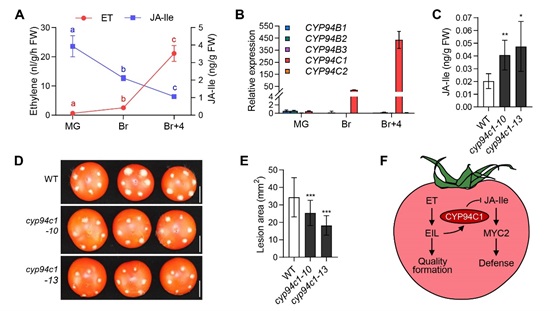Ethylene (ET) is a key ripening signal while jasmonate (JA) is a major defense hormone. In tomato, at the core of the ET signaling pathways are EIL transcription factors. Research group of Prof. LI Chuanyou, from the Institute of Genetics and Developmental Biology (IGDB), Chinese Academy of Sciences (CAS), previously revealed that EIL physically interacts with the Mediator subunit MED25, thereby orchestrating a hierarchical transcriptional cascade to promote quality formation in tomato.
In their recent study published in Molecular Plant (DOI:10.1016/j.molp.2024.02.004) on Feb. 7, they have elucidated the mechanism of underlying the increased susceptibility to necrotrophs during fruit ripening and have developed a rapid strategy to improve tomato fruit resistance to necrotrophs without compromising fruit quality.
As a widespread phenomenon in fleshy fruit species, ripe fruits are more susceptible to necrotrophic pathogens than unripe fruits. This sophisticated mechanism enables fruits to protect the developing seeds and facilitates the dispersal of mature seeds in nature but causes severe postharvest losses in production. Since most of fruit quality attributes are determined during ripening, breeding fruits resistance to necrotrophs without compromising ripening-related quality is a big challenge for many crops.
LI’s lab found that while ET production is highly induced by ripening, the levels of JA-Ile (the most bioactive form of JA) is markedly reduced during this process. Consistent with this, JA-mediated defense responses decrease during ripening. Further studies demonstrated that EIL directly activates the expression of CYP94C1, whose protein product in turn converts JA-Ile to the inactive form 12-COOH-JA-Ile, thereby attenuating JA-mediated defense during fruit ripening.
These results reveal the central role of
CYP94C1 in linking ET-mediated ripening and JA-mediated defense. It is likely that plants use JA to protect themselves
before seed maturation. Once the seeds mature, plants use ET to promote quality formation and remove JA-mediated defense, thereby facilitating the dispersal of the seeds.
Strikingly, knockout of CYP94C1 improves tomato fruit resistance to necrotrophs. Importantly, this strategy does not impair fruit ripening and quality, including days from anthesis to ripening initiation and levels of sugars, acids, lycopene, and ascorbic acid.
Furthermore, cyp94c1 mutation does not lead to unfavorable effects on growth and yield.
This study was funded by the National Natural Science Foundation of China, the Strategic Priority Research Program of the Chinese Academy of Sciences, and the Beijing Joint Research Program for Germplasm Innovation and New Variety Breeding.
Tomato CYP94C1 inactivates JA-Ile to attenuate JA-mediated defense during fruit ripening
Contact:
Prof. LI Chuanyou
Institute of Genetics and Developmental Biology, Chinese Academy of Sciences
 Tomato CYP94C1 inactivates JA-Ile to attenuate JA-mediated defense during fruit ripeningContact:Prof. LI ChuanyouInstitute of Genetics and Developmental Biology, Chinese Academy of SciencesEmail: cyli@genetics.ac.cn
Tomato CYP94C1 inactivates JA-Ile to attenuate JA-mediated defense during fruit ripeningContact:Prof. LI ChuanyouInstitute of Genetics and Developmental Biology, Chinese Academy of SciencesEmail: cyli@genetics.ac.cn CAS
CAS
 中文
中文




.png)
